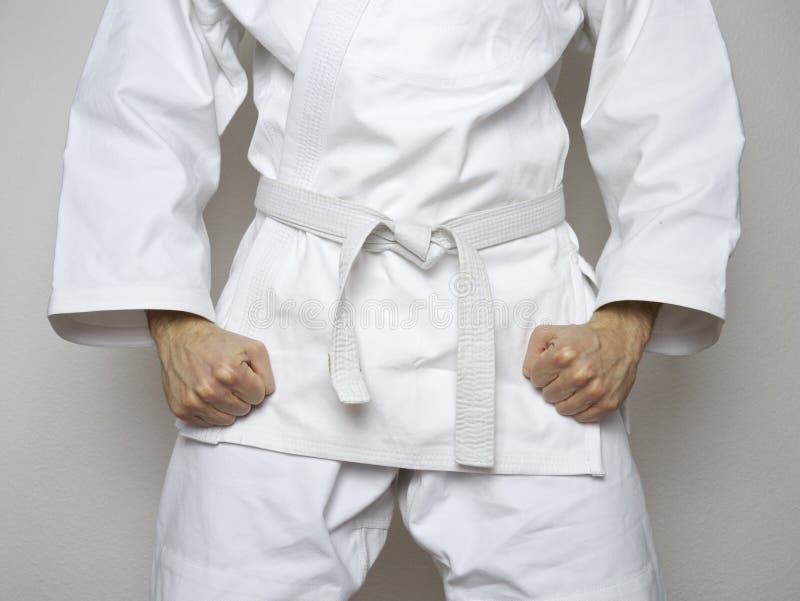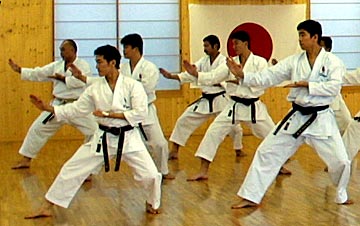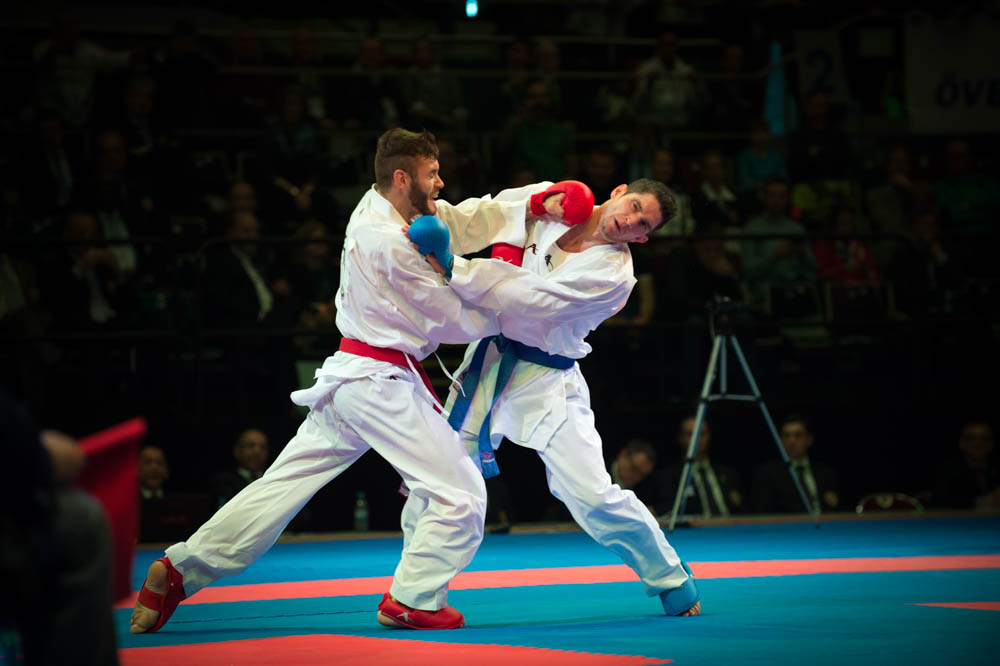Early
on Shotokan was made up of essentially two smaller groups set up in the university
system and a small group of senior professional instructor. It would not stay
this direct and small for long. The style BLEW up and dozens of off shoots were
formed and continue to form little off shoots for years to come. Groups
sloughed off of the main body as issues, personality clashes or just old
fashioned money arguments started to pile up and people through the hands up in
frustration or the larger groups would send them the “Dear John” letters
alerting them to the fact that they were no longer welcome in the family.
Some
left for more freedom, some left to rule their own fiefdoms, some left because
they did not get along and others left because they lacked patience or just
plan were feeling like they deserved more. Right or wrong the splits began with
little chunks of groups, single masters and clubs moving over and the once
clean and clear organization became a sea of new organizations, practitioners
getting more attention and then seeking to form their own groups.
Essentially
you have two main branches that form the Shotokan lineage or tree, the JKA and
the ShotoKai. Again, I have spoken at length about the Shotokai and The main
body of the JKA and I don’t want to rehash that here. The JKA branch however is
very interesting as it intersects with a lot of sub branches and groups that
can look back and say they were formed off the JKA branches.
The
JKA wing or branches origin falls under Masatoshi Nakayama and Isao Obata
Sensei’s as the leadership, creators or founders of the JKA. Yes Obata left and
came back and then left again but his money helped make the JKA and he deserves
recognition as one of the founding fathers of Shotokan Karate as a JKA entity.
From Masatoshi Nakayama Sensei however
we see a vast degree of changes and separations that create a flowing branch
with off shoots like crazy. At some point it’s important to note that Kanazawa
was the first real senior or “Big name” star to leave the JKA and his departure
was because of a change in his thinking, training and system he taught (well that’s
part of it). He also wanted financial separation from the JKA so he could make
a living and also he felt he was advanced enough to make his own way. Details
of that are for another time however.
Many
small off shoots appeared and have split away from the JKA over the years,
mostly ego, money and power issues caused the split, but the biggest split, one
that formed a huge separation was the
split with the Asai group, made up of many JKA seniors. The initial split
formed two sides, the JKA and Asai side, but what happened later is more
interesting. Now I know I have gone over this split before, but its important to
rehash a few details here to point out a interesting bit of info that I fell
upon a while back and just decided to clarify recently.
In
1987 the split occurred and both sides went to war, by 1999 the courts had
finally and completely sided with the Nakahara run JKA and expelled all the
Asai side members. The repercussions of this were far reaching, but I don’t
want to actually look at the JKA at this point. I want to go and check out the
Asai group.
While
the court battle was going on the Asai group was super close knit, they were
strong and they taught a brutally traditional system of Karate, Asai holding
close to the most detailed traditional system he could as he wanted to
following Nakayamas path and then veer slightly when he could. The court ruling
however allowed him to pull off his gloves and make changes to the training as
he wanted to, he began showing his own ideas and creating an “Asai Karate”
system that he had previously not demonstrated openly. He had researched
Chinese styles and had implemented some Kata changes previously but it was when
he realized he was not going to be the next JKA chief instructor that the changes
started coming fast and furious.
Abe
and Yahara split to form their own groups shortly after the court battle saw
them “no longer JKA”. Abe formed his JSKA to keep super traditional and honor
his instructor and Yahara formed his KWF to also go back to a more Budo style
art that he could put his own personal stamp on. However the whole point of
this blog is to look at what Asai did after finding himself on a splinter group
side and no longer the leader of a JKA group.
When
Asai Sensei lost the court battle he formed the JKS or Japan Karate Shotorenmei
as well as the International Japan Karate do Association or IJKA. The JKS was a
Japanese based group that began to teach the altered system of Asai Sensei and
allowed him to experiment and develop his system. Asai went about creating many
new Kata and introduced them to the students. The result was a style very unique and different than JKA style Karate with roots in the Japanese art but with a great deal of personal changes that he implemented after studying White Crane Kung fu.
The JKS became the Japan arm of Asai’s
teaching and much of his mainstream changes began with this group. He began
introducing different kata and movement drills to reflect changes he was
making. His students who had trained with him in the JKA Matsuno faction mostly
moved to this group when he lost in court. The changes in syllabus and
curriculum soon put the JKS membership at odds with each other and members like
Yahara, Abe and others left.
After
Asai Sensei passed away the organization was headed by Kagawa Sensei, a man
whom had a great tournament record and was perhaps more JKA than he was in line
with the New Asai Karate. The JKS began to change and move away from the change
that the former founder had put in place and move back towards solid
traditional JKA style Karate but they do maintain some of the changes and the
alterations that Asai Sensei had put into play, they just temper them a bit
with more traditional Shotokan ideals and movement patterns.
Along
with the JKS the IJKA was being run by Asai as his European branch. The main
instructor was Kato Sensei, who unlike Kagawa moved a great deal like Asai did
and the changes became second nature. The IJKA is probably the closest to the
changes that Asai wanted to put into effect of the two groups. Flowing, relaxed
and more Chinese than the JKS version of the changes the differences between
the two are striking when you see seniors practice side by side. However
watching their Kata demonstrations and Kato showing the proper form, you can
still see a great deal of Nakayama Sensei’s Karate influence.
My
impressions of the different movement skills of Kagawa, Kato and seniors from
these groups, the focus of the groups was similar, to spread the teachings that
they were introduced to by Asai Sensei. The JKS was based in Japan and had a
great deal of hype about being “The Asai” Sensei group. However the IJKA was
heavily represented in Europe, with a headquarters in the UK. The JKS has stretched out to some of the
world, but the IJKA seems to have started in Europe after Asai passed away.
Now
all this back ground has taken me to this point in talking about Asai Sensei
and his legacy. Other than the two “Official” or “Original” Groups of Asai
style Karate (and the many little off shoots like WTKO and others) there are now
two new groups set up to represent Asai Karate and they are very much different
from each other.
Upon
Asai Sensei’s passing his wife was sort of out of the Karate world for a bit, she had never really had much to do with Karate or running the organization before this as well.
The seniors did not really see her as having a place in the JKS or IJKA as she
was not a Karate practitioner. However as the wife of their late master she
still was afforded a great deal of respect, and a lot of students would contact
her and stop by her home to pay respect to Asai at the little temple they had
in the house. However she was not part of a board, she was not, obviously, part
of a senior council and I think this began to cause her distress. She felt that
she had inherited a right to the Karate system, or at least a piece of the
political pie.
The
JKS was run by Kagawa and Kato ran the IJKA and did not need her being
involved, which probably would have only lead to issues. However she did keep
tabs on them and at some point she decided she needed to “Protect Asai Karate”
and establish an organization to safeguard the memory of her late husband. At
first she approached a few people to assist her in setting up the group, but
shortly after it was established a few things became very clear and those who
had helped her set up this group left. One of the first things that came to
light was her assertions that Asai sensei “would have done it this way” and
using her late husband’s name to make some very strange decisions.
One
of the decisions she made was to hijack the IJKA name that Kato had been
running for years. She had fought with
Kata publicly and did not take well to his standing his ground to her. One of
the people helping her to set up the organization had warned her that the use
of the name could lead to issues, to which she ignored the suggestion and
bullied forwards.
The second and biggest issue that she created
was that she put her brother in charge as the Nidaime Shuseki Shihan or second
generation head of the style. Who cares if her brother never studied Asai Karate
and was a kung fu student who had limited interaction with Asai Sensei and his
Karate. Today the IJKA is an organization basically in Taiwan and has not grown
much aside from a sprinkling of Dojos in Europe and other Asian areas.
It
became very obvious that Mrs. Asai would attack anyone she felt would hinder
her progress, as extremely limited as it is. She posts on their web page the
dirty laundry most would not post and she attacks people who had been loyal to
Asai Sensei very publicly. A spat with one of Asai Senseis students was posted
on the web site and a picture that is obviously of Andre Bertal appears where
she says that the certificate he holds is not a real Asai certificate.
Mrs.
Asai also is prominent on the web page as she posts her ideas of Bushido and
other things, which as she is a non-practitioner of Karate makes it all the
more interesting.
No
other group I have seen does the kinds
of things that the IJKA out of Taiwan does, but that stands to reason as they
are not really high level Karate people and don’t have the depth of training or
knowledge most have. Its unheard of for groups to air dirty laundry like this….but
damn if it aint entertaining.
The
Mrs. Asai lead IJKA group created a conflict internally by not actually
focusing on Asai Karate, letting to much drama run the show and this lead to several
people leaving the group to form their own groups. One such separation created
the ASAI or Asai Shotokan Association International. The group was formed by
Yokota Kousaku, a former JKA member who worked with Okizaki Sensei of the ISKF
and had moved to the JKS before being a founding member of Mrs. Asai’s IJKA.
The ASAI group teaches 26 of Asai
Sensei’s additional Kata as well as a solid JKA based curriculum. The group was
forged out of Yokota Sensei’s trying to help Mrs. Asai set up the organization
that was supposed to be dedicated to continuing teaching her late spouses
system of Karate. To say that did not work out very well is a understatement. One
of Mrs. Asai’s personal attacks on her web site is dedicated to Mr. Yokota.
Having read both her site and his sites rebuttal I can say that he puts forward
a much better argument and is much more respectful than she is…..but go read
both for yourself.
The very public spat that came about
when he left did not look good for Mrs. Asai and ended up creating a new group
she has zero control over. In the end Yokota’s Asai Karate organization has
become much more prevalent and has a much better growth curve than the IJKA-Mrs.
Asai group. And as part of the full disclosure of this blog, I have been in
contact with Mr.Yokota about his group and he is super open and wants to share
his organizations goals and how he is running it with an open door policy and
no hidden agenda.
After Asai Sensei passed away he, much
like his mentor Nakayama Sensei, did not really leave one single person to
continue in his quest. Asai Sensei and his Karate are perpetuated by qualified
instructors like Yokota, Kagawa and Kato Sensei and their many followers, while
I remain JKA I respect the fact that Asai Sensei had some different ideas that
may very well be worth looking into and these men openly teach and train in the
system that he generated and perpetuated, unlike instructors like Chen Hontsung
and his sister these men will honor Asai and his traditions and create an open
door for people to continue training and growing in Karate.






